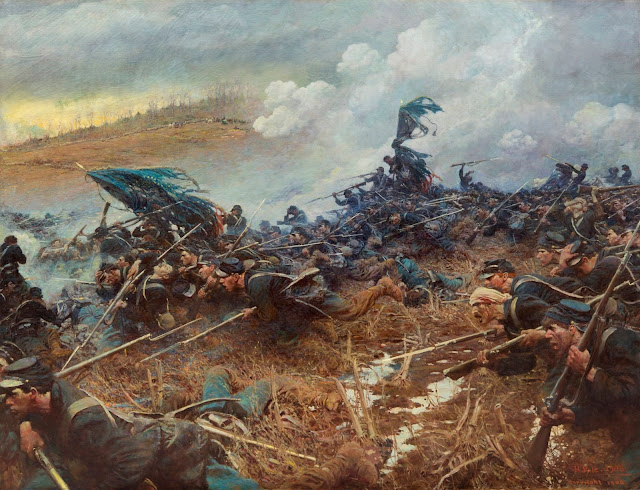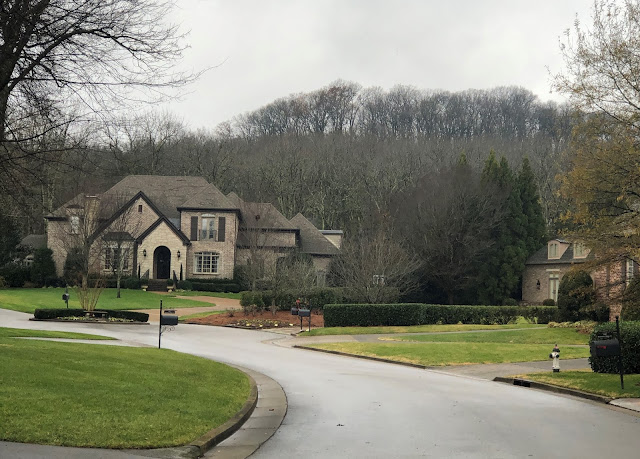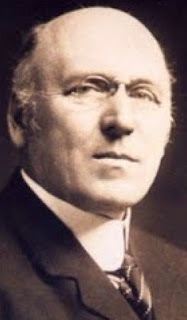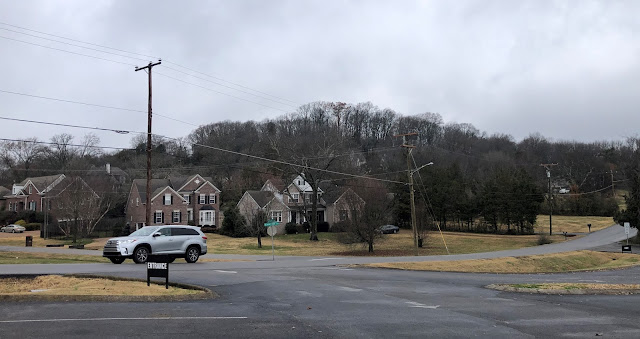Pyle's 1906 painting, "The Battle of Nashville," shows Minnesota troops fighting near Granny White Pike. (READ MORE ABOUT PAINTING.) |
Like this blog on Facebook | Follow me on Twitter
Before Howard Pyle created “The Battle of Nashville,” the famous painting showing the attack of Minnesota troops near Shy’s Hill, the renowned artist/illustrator did his homework. He studied historical accounts of the battle, interviewed veterans, examined a battle map, and even took several “large photographs” of the scene near Granny White Pike, where the Midwesterners fought.
Oh, my, how we’d love to see those images today.
What was open ground early in the 20th century, when Pyle painted the scene, is now an upscale residential area. The cornfield where Minnesota troops charged on Dec. 16, 1864, during the Federals' rout of the Army of Tennessee, well, that’s now occupied in part by a recently constructed private school.
At least two veterans weren't pleased with Pyle’s painting, which has been displayed at the State Capitol building in St. Paul, Minn., since it was unveiled in the fall of 1906. It has no historic value, Thomas G. Carter, an officer in the 7th Minnesota, complained to the Minneapolis Journal.
Carter was offended that the painting only showed the attack by two regiments of Minnesota troops – the 5th and 9th infantry, II Brigade troops commanded by future Minnesota governor Lucius Hubbard. The 7th Minnesota, III Brigade troops under William R. Marshall, and the 10th regiment in the I Brigade, commanded by William L. McMillen, were not depicted. (See battle map below.)
“Captain Carter, after inspecting the painting, says it makes the men look bloodthirsty and fierce,” the Minnesota Journal reported on Nov. 6, 1906, “but it is nothing more than a picture of the advance of … Hubbard’s brigade.”
“Battle Picture Bad Historically,” read the headline in the newspaper. “Seventh Regiment Out in the Cold,” read a headline on a follow-up story in the Journal two weeks later.
Pyle, who died in 1911, said he couldn’t show all the Minnesota regiments advancing because their battle line was too long for a 6-by-8-foot painting. Hubbard reportedly was also disappointed the painting didn’t show all four Minnesota regiments.
"It is possible that the Tenth is represented in the painting,” Carter groused about the unit that attacked closer to Shy’s Hill, “but if so the smoke hides it. In reality, the smoke hides it, mostly. In reality, there is too much smoke.” Carter also said Pyle got the topography wrong.
Perhaps another look at those photos Pyle took in 1906 – if they still exist -- might bring some clarity to this footnote in history.
Battle map shows advance of three Union brigades on Dec. 16, 1864. (Battle of Nashville Trust via Guide to Civil War Nashville) |
The Union II Brigade, which included the 5th and 9th Minnesota, advanced across present-day Harding Place Road. Historic Granny White Pike is at left. |
A view of Shy's Hill looking roughly west from the parking lot of a modern church near Granny White Pike. |
A historical marker along Granny White Pike. The II Brigade advanced on ground to the right of the pike. It's a residential neighborhood today. |
SOURCES
--The Minneapolis Journal, Oct. 9, Nov 6, Nov. 19, 1906.
Continue reading...










